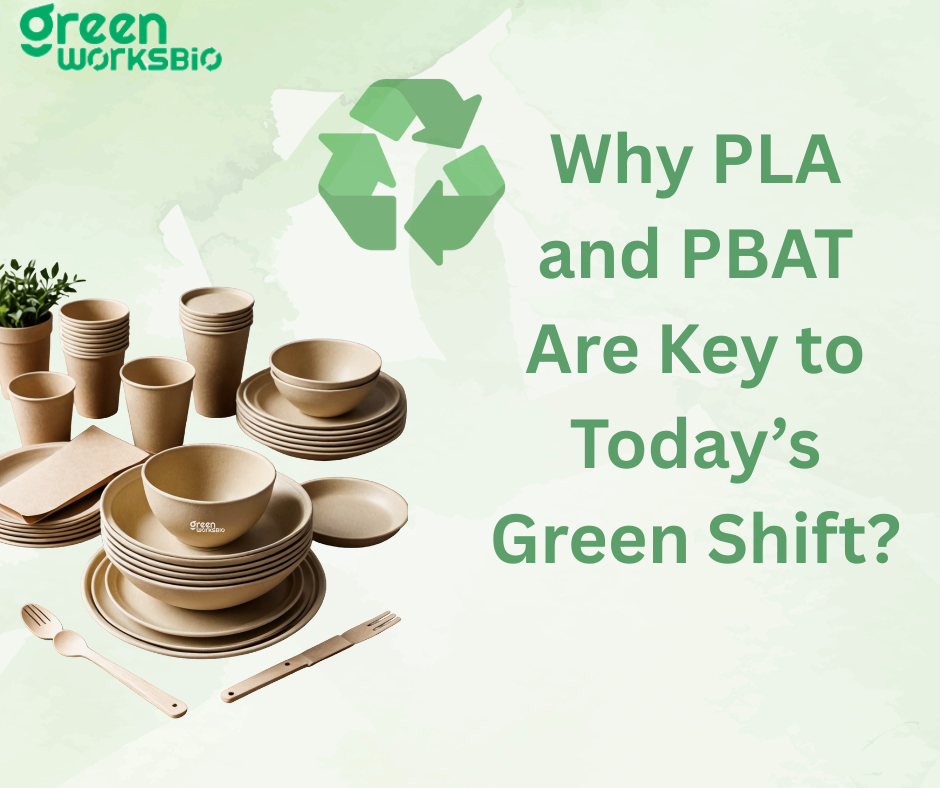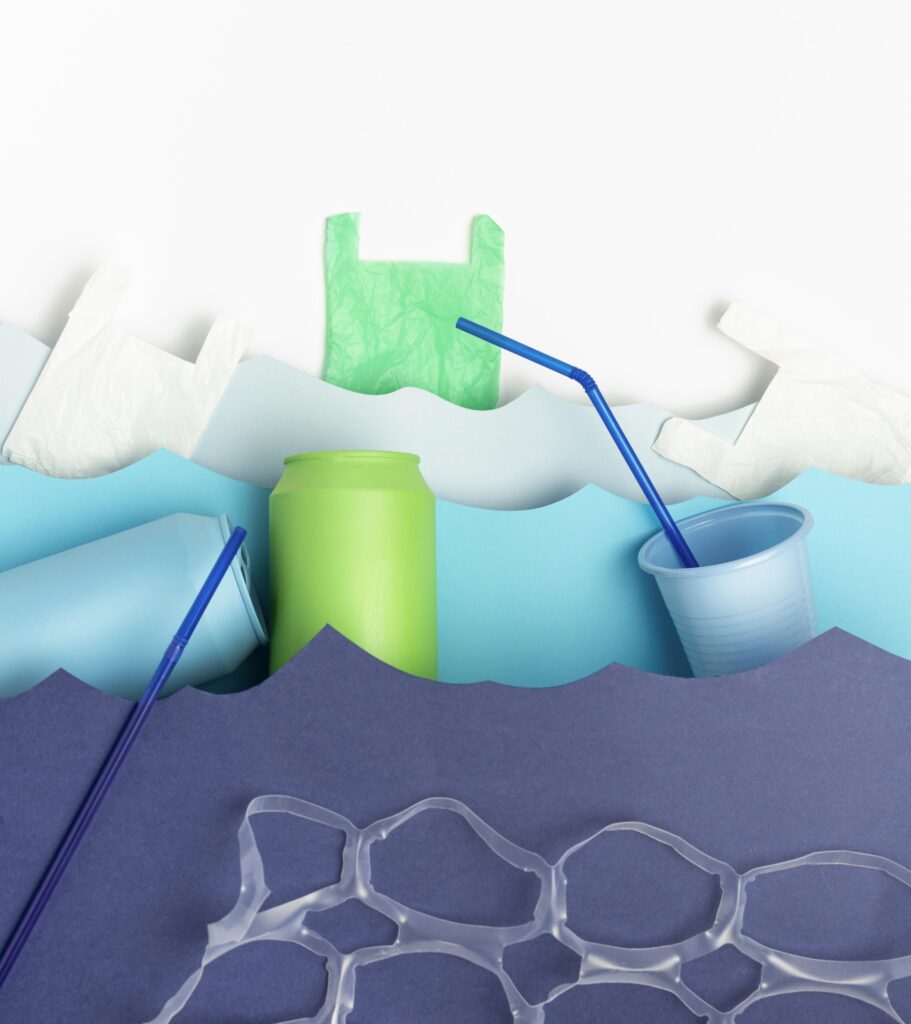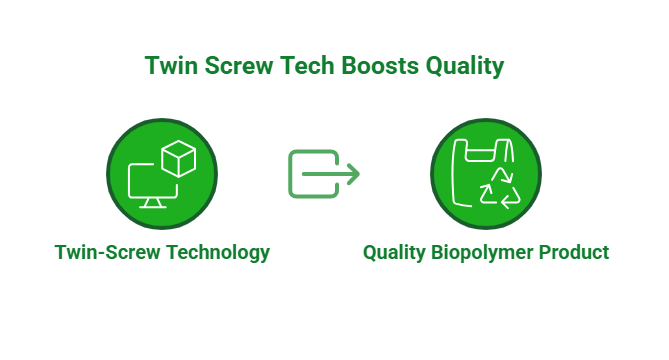| TL;DR
India is poised to become a global hub for PLA biopolymer production. Rise in plastic pollution drives demand for eco-friendly alternatives. PLA and PBAT are key biodegradable plastics across sectors. Major applications: packaging, agriculture, e-commerce, and healthcare. Local production reduces import dependency and logistics costs. Twin-screw tech enhances biopolymer quality and customization. Modular Production Drives Sustainability in Biopolymer Manufacturing. Greenworksbio contributes to this mission by offering innovative, eco-friendly products that help reduce plastic waste and foster a greener future. |
Every day, millions of plastic items are used and discarded in India, contributing to an escalating environmental crisis. As of 2025, India generates over 9.46 million tonnes of plastic waste annually, but 40% of this plastic goes uncollected (Source). This leads to polluted streets, overfilled landfills, and plastic debris in waterways.
In response to this growing concern, there is a global shift towards sustainable, bio-based materials. Among these, Polylactic Acid (PLA) and Polybutylene Adipate Terephthalate (PBAT), which includes terephthalic acid and adipic acid, have emerged as frontrunners in the biopolymer sector. PLA is a biodegradable polymer made from corn or sugarcane, ideal for compostable plastics, disposable tableware, and packaging. PBAT is petroleum-based but still biodegradable, offering flexibility for films and bags, and is often used in such blends with PLA.
This blog explores how India can harness its agricultural resources, technological advancements, and supportive policies to become a global hub for PLA biopolymer production. By addressing the leveraging the opportunities, India can play a pivotal role in the global movement towards sustainable materials.
What Makes PLA and PBAT Integral in Today’s Shift Toward Greener Alternatives?

As plastic waste continues to rise and industries face pressure to adopt sustainable materials, two names, PLA (Polylactic Acid) and PBAT (Polybutylene Adipate Terephthalate), which contain butylene, are emerging as front-runners in the green packaging revolution.
Their mechanical strength supports a wide range of applications, including eco-friendly food packaging solutions like Greenworksbio’s Compostable Tableware, which exemplify sustainable alternatives in the industry. Backed by the latest 2025 market data and widespread cross-sector use, these materials are driving the shift away from traditional plastics.
1. What Is PLA and Why Is It Gaining Global Momentum?
PLA (Polylactic Acid) is a plant-based biopolymer made from renewable resources such as:
- Plant starch
- Corn starch
- Sugarcane
- Sugar beet pulp
Breaks down naturally in industrial composting environments through microbial action, leaving no harmful residue.
The global PLA market, valued at USD 3,060B in 2025, is growing steadily, with 60% of bioplastic packaging now using PLA and rising demand in 3D printing, electronics, and medical devices.
2. How Is PBAT Different and Still Important?
PBAT is petroleum-derived, but unlike traditional plastics, it’s biodegradable. What sets PBAT apart is its flexibility and toughness, which make it ideal for products that need to bend, stretch, or seal, such as cling films, shopping/carry bags, and agricultural mulch films. PBAT adds softness and stretch, making the PLA–PBAT blend ideal for compostable packaging.
3. Why Are PLA and PBAT Crucial for FMCG, Agriculture, E-commerce, and Healthcare?
PLA and PBAT blends are tackling plastic waste across industries with heat resistance, compostability, and consistent performance in novel composites.
- FMCG uses them for food-safe trays and cutlery
- Agriculture benefits from biodegradable mulch films
- E-commerce brands adopt compostable mailers and wraps
- Healthcare relies on PLA for sutures and safe packaging
Why Is India Uniquely Positioned to Lead the Global Biopolymer Boom?
According to the Bioplastics Global Overview Report 2024-2030, the global bioplastics market was valued at $14.1 billion in 2024 and is expected to grow at a CAGR of 16.9% annually from 2024 to 2030. This rapid growth is driven by rising demand for innovative eco-friendly packaging solutions in industries like packaging, agriculture, and healthcare.
Despite the growing global market, India still relies heavily on imports for biopolymer products. Its deep-rooted dependence on Chinese imports has contributed to a trade deficit nearing $100 billion in FY2025, exposing a strategic vulnerability in securing essential materials. This reliance risks supply disruptions in critical sectors such as biopolymer manufacturing.
To reduce import dependence and meet rising demand, India has begun developing domestic biopolymer production. A landmark project in Uttar Pradesh is underway, involving an investment of about Rs 2,880 crore to build the country’s first large-scale PLA biopolymer plant. This facility will initially produce 80,000 tonnes per year and run entirely on renewable energy, aligning with India’s sustainability goals and helping build a greener, more resilient economy.
Why Is Modular Production More Sustainable for Biopolymer Manufacturing?

According to a 2025 Manufacturing Report, traditional biopolymer manufacturing depends on large, centralized plants that cost over $200 million and take time to set up, making them slow to adapt. This outdated approach is especially challenging in emerging markets like India, where land, logistics, and policy hurdles further slow down deployment. Batch systems also lack the flexibility to meet fast-changing sustainability and market demands. This creates bottlenecks in scaling up eco-friendly alternatives like biopolymers.
How Modular Continuous Production Has an Edge Over Traditional Manufacturing?
Modular systems are compact, flexible, and scalable, using prefabricated units for quick installation and integration.
- They lower costs and speed up production deployment.
- Real-time monitoring and precise material use boost operational efficiency and reduce environmental impact.
- Decentralized plants can be located near raw materials or markets, cutting transportation emissions.
- This approach helps companies meet global sustainability demands while remaining cost-effective.
Greenworksbio is embracing this shift by adopting modular, decentralized production systems that scale with demand and reduce carbon footprints. This approach supports faster market entry and innovation while aligning with India’s push for self-reliance. Learn more about Greenworksbio’s sustainable solutions here.
How Twin-Screw Technology Enhances Biopolymer Quality?

The global twin-screw extruders market was valued at USD 2,992.6 million in 2024 and is expected to grow to USD 4,755.8 million by 2033, with a compound annual growth rate (CAGR) of 5.3% between 2025 and 2033. Twin-screw technology improves biopolymer quality by enabling better mixing, precise control, and consistent processing. This results in customizable materials with enhanced performance and durability.
1. What Role Does Twin-Screw Technology Play in Production?
Twin-screw extruders play a vital role in biopolymer manufacturing, especially for processing biodegradable plastics like PLA and PBAT. Their design and functionality offer several advantages:
- Superior Mixing & Extrusion: Two intermeshing screws rotate in either a co-rotating or counter-rotating manner, allowing efficient blending of raw materials.
- Precise Control: They enable accurate regulation of processing conditions, resulting in stable and consistent production rates.
- Uniform Dispersion: Additives and fillers are evenly distributed, improving material properties and product quality.
- Ideal for Biodegradables: Especially effective in handling PLA and PBAT polymers, making them essential for producing high-quality, sustainable materials.
2. How Does Twin-Screw Tech Enable Custom Materials?
Indian industries, especially in packaging, agriculture, and healthcare, require biopolymers with specific, tailored properties. Twin-screw extruders help meet these needs through the following capabilities:
- Customizable Output: Adjustments in processing conditions and additives enable control over flexibility, biodegradability, and thermal stability.
- Supports Diverse Blends: Ideal for producing a wide range of biopolymer formulations to suit different industrial needs.
- Key Applications: Useful in creating:
• Sustainable packaging materials
• Agricultural films
• Biocompatible medical products - Strategic Fit for India: Aligns with India’s goals of environmental sustainability and self-reliant manufacturing.
Golden Wings Bioplastics integrates twin-screw technology into its biopolymer production to refine PLA and PBAT blends. This approach enables better material customization, aligning with the company’s focus on innovation and sustainable manufacturing.
Can Local Biopolymers Power India’s Green Economy?
Establishing domestic biopolymer manufacturing in India offers significant economic and environmental advantages. By reducing reliance on imports and promoting sustainable practices, this shift aligns with national goals of self-reliance and ecological responsibility.
1. How Does Local Biopolymer Production Boost Economy?
Local biopolymer production offers significant advantages for India’s economy. It not only boosts employment but also helps build a stronger, more self-reliant industrial ecosystem.
- Creates new job opportunities across manufacturing, research, and logistics.
- Reduces India’s dependence on imported biopolymers, improving trade balance.
- Conserves foreign exchange by cutting down import costs.
- Strengthens local industries, making them more resilient to global supply disruptions.
2. What Are the Environmental Benefits of Local Production?
Biopolymers typically have a lower carbon footprint compared to conventional plastics. For instance, replacing petroleum-based plastics with bioplastics can reduce greenhouse gas emissions by approximately 30%. Moreover, biopolymers are integral to the circular economy model. They facilitate waste valorization, turning agricultural and industrial residues into valuable products, thereby minimizing resource consumption and waste production.
Also, certain biopolymers courier bags and water bottles, are compostable, offering sustainable waste management solutions. This characteristic is particularly beneficial in urban areas, where plastic waste management poses significant challenges.
Which Government Policies and Partnerships Are Driving India’s Biopolymer Growth?
Supportive policies and strategic collaborations play a vital role in advancing India’s biopolymer sector. Together, they create a foundation for sustainable growth and innovation.
1. What Government Incentives Are Fueling Biopolymer Manufacturing?
India’s commitment to enhancing its biopolymer sector is evident through various policy initiatives. The Production Linked Incentive (PLI) schemes have attracted investments worth INR 1.76 trillion (approximately $20.3 billion) across 14 sectors by March 2025, generating over 1.2 million jobs. The BioE3 Policy got approved in August 2024, aims to foster high-performance biomanufacturing, focusing on biotechnology for economy, environment, and employment .
Furthermore, the National Bioplastics Policy recommended by EY and ASSOCHAM, suggests fiscal incentives, including capital subsidies of up to 50% on eligible investments over five years, and interest subvention at 7% for 7 years, to stimulate bioplastics manufacturing and infrastructure development.
2. Why Are R&D, Public-Private Partnerships, and Standardization Crucial?
Research and Development (R&D) play a pivotal role in advancing biopolymer technologies. The BioE3 Policy emphasizes the importance of R&D in driving sustainable biomanufacturing and fostering innovation in biotechnology.
Public-private partnerships are instrumental in developing standards and regulations that ensure the quality and safety of biopolymers. Collaborations between government bodies and industry stakeholders facilitate the establishment of robust regulatory frameworks, promoting the growth of the biopolymer sector.
Greenworksbio supports India’s biopolymer growth with innovative, scalable solutions and advanced technologies to enhance product performance and sustainability.
How Is Greenworksbio Leading Sustainable Biopolymer Solutions?
At Greenworksbio, we offers innovative biopolymer solutions made from biodegradable PLA and PBAT, helping businesses reduce plastic dependency without compromising on quality or performance. From food packaging to industrial applications, our products are designed for circular economy goals, offering scalability, durability, and eco-safety.
Explore our product range to find the right fit for your sustainability goals.
Conclusion
India’s biopolymer journey is gaining momentum, powered by government support, industry innovation, and rising environmental awareness. From reducing plastic waste to building a circular economy, every step matters in this crucial phase. Whether you’re a business exploring greener materials or just curious about sustainable tech, now’s the time to stay informed about the latest research supported by DOI.
The question is no longer if India will embrace local biopolymer production, but how quickly we can lead the global transition. The time to act is now. Get involved and be part of the change.
Frequently Asked Questions
How does the biodegradability of PLA and PBAT compare with other bioplastics?
PLA and PBAT demonstrate superior biodegradability compared to conventional plastics and compost, representing a step towards a more sustainable future with various applications. However, their rates of biodegradation and stiffness at end of life can vary compared to other bioplastics like PHA and starch-based types, including microorganisms, which affects plastic pollution and reliance on fossil fuels.
What challenges does India face in sourcing raw materials for PLA and PBAT production?
India faces significant challenges in sourcing raw materials for PLA and PBAT production, including limited availability of feedstock, high dependency on imports, fluctuating prices, and insufficient local recycling infrastructure. These factors hinder the growth potential of India’s biopolymer industry amidst increasing global demand.
How do consumer awareness and acceptance impact the growth of biopolymer markets in India?
Consumer awareness drives demand for sustainable, biodegradable products and encourages businesses to switch to biopolymer packaging. Higher acceptance accelerates market growth, prompting investment in local production and innovation, and ultimately supporting India’s sustainability and environmental goals.

